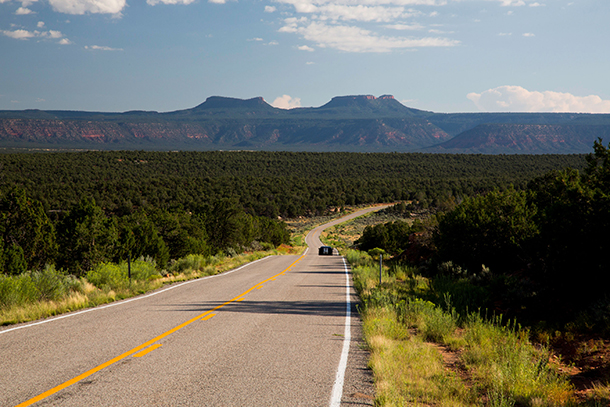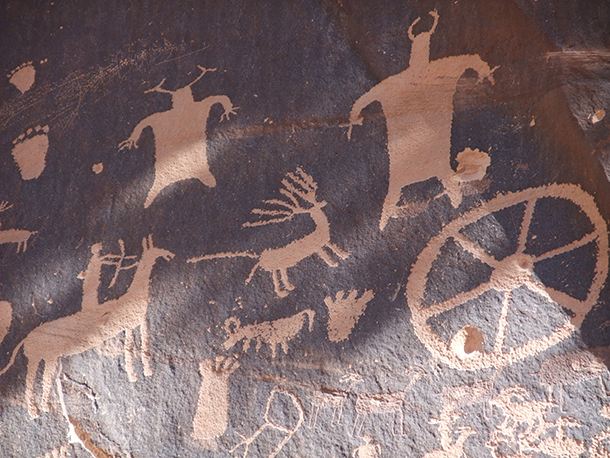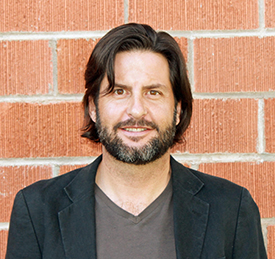Saving Bears Ears
Air Date: Week of January 6, 2017

The new Bears Ears National Monument, named for two buttes that rise above the southern Utah landscape, covers 1.35 million acres. (Photo: Bureau of Land Management)
1.3 million acres of wilderness that include a pair of buttes in Southeastern Utah that look like Bears Ears have joined the list of National Monument designated by President Barack Obama as he ends his term. Host Steve Curwood and Jonathan Thompson of High Country News discuss the ecological and cultural importance of the designation, including the Native American role in the monument’s creation and administrative structure.
Transcript
CURWOOD: From the Jennifer and Ted Stanley Studios at the University of Massachusetts Boston and PRI, this is Living on Earth. I’m Steve Curwood.
US presidents can create the virtual equivalent of a national park with the stroke of pen, thanks to the 1906 Antiquities Act, signed by Teddy Roosevelt. And in the final months and weeks of Mr. Obama’s term that pen has been busy. He has declared national monuments covering vast marine areas as well as in wild and scenic places such as the North Maine Woods. And during the holiday season he added to the list. Expanding the area already protected by the Grand Canyon-Parashant National Monument in Arizona, President Obama added some 300,000 acres of the Gold Butte region right across the border in Nevada. And in a deal put together with unprecedented cooperation of Native Americans he designated one point three million acres of southeastern Utah in the Bears Ears region. Jonathan Thompson is a contributing editor for High Country News who closely followed the special process for Bears Ears, and he join us now.
Welcome to Living on Earth.
THOMPSON: Glad to be here, Steve.
CURWOOD: Talk to me about the value of Bears Ears, both in terms of its natural geography and its historical sacred value to Native Americans.

Ancestral Puebloan cliff dwelling within the new national monument boundaries. (Photo: Jonathan Thompson)
THOMPSON: Well, you know, as far as the environment goes it covers a pretty diverse piece of land that goes from high mesas and sort of mountain areas down to barren desert. It's part of Utah's canyon country and so you've got these deep beautiful canyons that have creeks running through them. Some of these creeks, in fact, have fish in them that are only found in those canyons. But, really, when it comes to the significance of the Bears Ears Monument, really it's the prehistorical elements that are really important, and there's tens of thousands of archaeological sites there, and they range from about 12,000 years ago to - Clovis sites - to about, I mean really to present time because the archaic Indians were there and then the Puebloans came in and actually started settling the area. They were the first ones to really actually live on the area. They came around a little bit before the birth of Christ.
CURWOOD: Talk to me about the Clovis civilization, what was found at Clovis. Some of the people listening to us may not have studied archaeology that much.
THOMPSON: Yeah these were a nomadic people. The main thing that we found from them is spear heads and sort of the remnants of camps. There is a Clovis camp actually located on the Bears Ears monument, so that's probably the oldest human remains there.
CURWOOD: And did they draw at all?
THOMPSON: No, not that we know of. I don't think there's much evidence of that.
CURWOOD: I understand there's lots of rock art in the Bears Ears area. Where did that come from?
THOMPSON: That came from the Puebloans. They came later. There's a great deal of amazing petroglyph panels. Petroglyph is when you -- They carved it into the rock itself as opposed to painting on the rock, so the petroglyphs naturally last longer and some of the ones in the Bears Ears I would say are some of the best anywhere.
CURWOOD: So how was all this rock art in the Bears Ears area being taken care of before?
THOMPSON: Well, all the rock art theoretically is protected by the Archaeological Resource Protection Act which was passed in the 1970s, but in reality, you know, it's pretty hard to protect these resources because they're scattered over such a huge area, and I believe that there's one law enforcement officer for the Bureau of Land Management for this entire corner of the state. I mean, it's really crazy. And so, what you're seeing is a great deal of vandalism, not just of the petroglyphs, but in some cases, really recently, just maybe in the last year I believe, one of these petroglyphs…Somebody went in with a rock saw and tried to chop it off in order to take away. And so, one of the main things that people are trying to achieve with this monument is to bring in more enforcement. You know, the laws exist to protect these things already, but the enforcement is not there.

Looking into the new national monument. The butte on the horizon is one of the Bears Ears, and the second ear barely hovers above the horizon line. (Photo: Jonathan Thompson)
CURWOOD: The people have been fighting to make these areas monuments for some time. Talk to me about the other efforts that took place to protect Bears Ears.
THOMPSON: Well, yeah. Bears Ears has been going on since...I believe it was in 1936 that then Secretary of the Interior Harold Ickes proposed a four million acre National Monument for that entire corner of the state, and it would've included Bears Ears but also several other places. It didn't go through, but over the years you got Canyonlands National Monument, which was a piece of that four million acres got designated, and then you got Natural Bridges National Monument as well as Capitol Reef, but the Bears Ears, which was kind of the heart of this four million acre monument proposal, never got much in the way of protections. But at the same time, there's been efforts since the '30s to protect that area somehow, and they've never made it. There's never been anything big. It's always sort of incremental things. Getting cattle shut out of one canyon or getting one road shut down to motorized vehicles or that sort of thing. And so, this is really a culmination of many, many decades of work.
CURWOOD: I understand that tribes with historic ties to this region were involved in this Monument designation process in a way that they really haven't been involved before. Who are these Native American groups, and what role did they actually play in the creation of this Monument?
THOMPSON: Well, the Native American groups are two different tribes of the Ute People and the Zuni Tribe, and Hopi Nation and the Navajo Nation. So, there are five tribes that were the main players in this spearheaded by a group of local Navajos who formed a nonprofit called Utah Dine Bikeyah which means Utah Navajo homeland basically. After they got the ball rolling then they went to these other tribes and they said, “We need your help”, and so they came together as a tribal coalition, and it was that coalition of these five tribes that went to Washington and presented this proposal to Obama.
CURWOOD: And will be the roles of these tribes moving forward now that it is a Monument?
THOMPSON: Now that it is a Monument, this is really the kind of the most remarkable thing I think about this Monument is that it will be managed by the Department of Interior and Department of Agriculture, but there will be a commission made up of one elected official from each of these tribes, of each of these five tribes, and they will have a very strong advisory role. So, in a sense, they will be jointly managing this monument with the Department of the Interior and the Department of Agriculture.
CURWOOD: Now, Indian Country is not monolithic. I understand that some native groups were not pleased by this.
THOMPSON: Well, so the people who were opposed to this were mostly local Navajos and Utes, and both of these tribes, the tribal governments were behind the Monument and they were part of the tribal coalition, so these are individuals within those tribes who oppose it, and they opposed it for various reasons. Some of that was ideological concerns that are the same as the local white people who opposed it. Others are worried that they will lose access to the land for stuff like firewood gathering, herb gathering, and maybe ceremonial uses. The proclamation for the Monument actually addresses that and says that those uses will be preserved. So I think some of those concerns will be allayed. The ideological ones will not, but elected officials of theirs will be on this tribal committee, and so they will presumably have a voice in how the Monument is managed through them.
CURWOOD: Now what areas were included in the initial proposal that are absent from this final Monument designation, and why didn't they make the cut?

Petroglyphs at Newspaper Rock, an important archaeological site that’s now part of the new Bears Ears National Monument. (Photo: akademy, Flickr CC BY-NC-ND 2.0)
THOMPSON: Yeah, that's a good question. The Obama administration didn't really play this up at all, and in fact, they didn't even mention it. What the tribes proposed was a 1.9 million acre Monument. What ended up being actually designated was 600,000 acres less than that, and, really, nobody's actually come out and said this, but really it looks like it was in order to appease the local opposition. One area that was cut out was the Abajo mountains which are right next to the county seat of Monticello and it's a big area for recreation for locals as well as a place that they get firewood and that they actually get their municipal water. That was clearly a concession to locals.
There's another area that could be a uranium mining area if uranium mining never comes back, and that was cut out of the ultimate Monument. So, basically the administration I think was trying to compromise a little bit in this designation, although the locals so far have not seen it that way, and they're also very, so far very ardently hoping to get this overthrown.
CURWOOD: Talk to me about the opposition to the creation of this new Monument. What efforts are they are making, or might make, to try to get this overturned?
THOMPSON: Yeah, so the opposition really includes a lot of locals, but not all the locals in San Juan County and that's something really that should be pointed out is that it's not monolithic there either. But it includes a lot of locals there, and it includes a lot of Utah politicians, and really it comes down to a state's rights kind of thing, in part. I think it also comes down in part to a dislike of Obama. They are trying various channels to get Trump to overturn this, and theoretically because it was a presidential act through the Antiquities Act, theoretically the president can overturn it. But no one knows yet. That's never been tried before, so no one knows yet what that really would entail or how hard that would be. And also no one knows if Trump actually would actually go for it.

Jonathan Thompson is a contributing editor for High Country News. (Photo: Lydia Thompson)
CURWOOD: Jonathan, tell me of a spot that you've been to in Bears Ears that, well, takes your breath away.
THOMPSON: Wow, you know, there's so many spots in that area. I grew up in Durango, Colorado, which is not far, a couple hours drive from the Bears Ears, and I spent a great deal of time in the Bears Ears area as a kid and as a teenager and as a young man. And the Bear Ears themselves, they're just two buttes and they are not anything super spectacular to look at. They are two buttes that kind of look the same and they are next to each other and they look like a pair of Bears Ears. But when you're up on top of them you can see really the whole region and you look down kind of into Dark Canyon which is this deep crevasse that goes down to the Colorado River. You look down into Arch Canyon, this incredible canyon with natural arches, a creek at the bottom and it's got these.. some archaeological sites, some cliff dwellings and some granaries way up on the cliffs way up there that are just...I mean it's kind of befuddling to wonder how people even got there in the first place to build these things.
CURWOOD: Now, Jonathan, of course, you're a journalist, you're fair and balanced and objective, but how do you feel about these designations of Monuments?
THOMPSON: I hope that what it does do is that it brings more resources for enforcement of existing laws as well as more resources for education. I also, I really do think that the tribal involvement is critical here because aside from giving them sort of some say and power over how this land is managed, it also gives them more of a voice in telling the story, their story of their connection to that land, and so I'm really excited about that, you know, more than anything.
CURWOOD: Jonathan Thompson is a contributing editor for High Country News. Thanks so much for taking the time with us today, Jonathan.
THOMPSON: Thank you, Steve.
Links
White House press release about the monument
The Wilderness Society analysis and description of Bear’s Ears
The Wilderness Society analysis and description of Gold Butte
High Country News: A parcel of the then-proposed Bears Ears monument was sold in October 2016
Living on Earth wants to hear from you!
Living on Earth
62 Calef Highway, Suite 212
Lee, NH 03861
Telephone: 617-287-4121
E-mail: comments@loe.org
Newsletter [Click here]
Donate to Living on Earth!
Living on Earth is an independent media program and relies entirely on contributions from listeners and institutions supporting public service. Please donate now to preserve an independent environmental voice.
NewsletterLiving on Earth offers a weekly delivery of the show's rundown to your mailbox. Sign up for our newsletter today!
 Sailors For The Sea: Be the change you want to sea.
Sailors For The Sea: Be the change you want to sea.
 The Grantham Foundation for the Protection of the Environment: Committed to protecting and improving the health of the global environment.
The Grantham Foundation for the Protection of the Environment: Committed to protecting and improving the health of the global environment.
 Contribute to Living on Earth and receive, as our gift to you, an archival print of one of Mark Seth Lender's extraordinary wildlife photographs. Follow the link to see Mark's current collection of photographs.
Contribute to Living on Earth and receive, as our gift to you, an archival print of one of Mark Seth Lender's extraordinary wildlife photographs. Follow the link to see Mark's current collection of photographs.
 Buy a signed copy of Mark Seth Lender's book Smeagull the Seagull & support Living on Earth
Buy a signed copy of Mark Seth Lender's book Smeagull the Seagull & support Living on Earth

